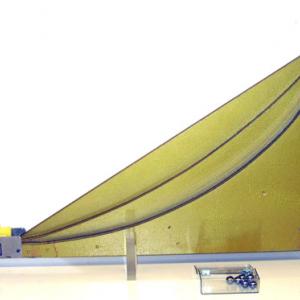College of Liberal Arts & Sciences
1D15.50 - Brachistochrone
Video and Editing Credit: Jonathan M. Sullivan-Wood.
The balls will start and end at the same height. The route is different and hence the time that the ball takes will be different also. The standard demonstration has a straight track, a circular track, and a cycloid track. Using the carbon paper will enable you to show that the balls have the same energy when they leave the track.
- Yiqi Fang, Xianle Zeng, Rongyu Fan, Zhu'an Chen, Marcelo F. Ciappina, "A Minimization Problem Based on Straight Lines", TPT, Vol. 62, #5, May 2024, p. 387.
- John A. Milsom, "The Brachistochrone: An Excellent Problem for All Levels of Physics Students", TPT, Vol. 59, #8, Nov. 2021, p. 606.
- Leonid Minkin and Percy Whiting, "Restricted Brachistochrone", TPT, Vol. 57, #6, Sept. 2019, p. 359.
- D. Figueroa, G. Gutierrez, and C. Fehr, "Demonstrating the Brachistochrone and Tautochrone", TPT, Vol. 35, #8, Nov. 1997, p. 494.
- Alan Cromer, "An Unusual Rolling-Sphere Phenomenon", TPT, Vol. 34, #1, Jan. 1996, p. 48.
- Dale T. Hoffman, "A Cycloid Race", TPT, Vol. 29, #6, Sept. 1991, p. 395.
- Kevin J. Tillotson, "Who Will Win the Race, II?", TPT, Vol. 28, #8, Nov. 1990, p. 537.
- Julius Sumner Miller, "Further to the Brachistochrone", TPT, Vol. 24, #5, May 1986, p. 262.
- R. D. Edge, "The Brachistochrone - Or, The Longer Way Round May be the Quickest Way Home", TPT, Vol. 23, #6, Sept. 1985, p. 372.
- Thomas B. Greenslade Jr., "Brachistrochrone Demonstration", AJP, Vol. 81, #1, Jan. 2013, p. 19.
- Thomas B. Greenslade Jr., "Time of Descent Apparatus (Photo)", AJP, Vol. 72, #12, Dec. 2004, p. 1500.
- S. E. Joens, T. M. Antatnackovic, and M. Dehn, "Remarks on the Brachistochrone with Viscous Friction", AJP, Vol. 56, #8, Aug. 1988, p. 758.
- H. A. Yamani and A. A. Mulhem, "A Cylindrical Variation on the Brachistochrone Problem", AJP, Vol. 56, #5, May 1988, p. 467.
- David G. Stork and Ju-xing Yang, "The General Unrestrained Brachistochrone", AJP, Vol. 56, #1, Jan. 1988, p. 22.
- David Stork, "Problem: The Unrestrained Tachistos", AJP, Vol. 55, #4, Apr. 1987, p. 296, 376.
- Ju-xing Yang, David G. Stork, and David Galloway, "The Rolling Unrestrained Brachistochrone", AJP, Vol. 55, #9, Sept. 1987, p. 844.
- David G. Stork, Ju-Xing Yang, and Chris Stover, "The Unrestrsained Brachistochrone", AJP, Vol. 54, #11, Nov. 1986, p. 992.
- Daniel T. Giellespie, "Simple Harmonic Motion of a Round Body Rolling on a Concave Curve", AJP, Vol. 52, #2, Feb. 1984, p. 180.
- P. K. Aravind, "Simplified Approach to Brachistochrone Problems", AJP, Vol. 49, #9, Sep. 1981, p. 884.
- N. Ashby, W. E. Brittin, W. F. Love, and W. Wyss, "Brachistochrone With Coulomb Friction", AJP, Vol. 43, #10, Oct. 1975, p. 902.
- Brian Holton, "Go Big or Go Home", PIRA Newsletter, Vol. 11, #1, Oct. 1996, p. 5.
- Wallace A. Hilton, "M-14a. Conservation of Energy", Physics Demonstration Experiments, p. 31.
- George M. Hopkins, "Falling Bodies - Inclined Plane - The Pendulum", Experimental Science, p. 38 - 43.
- R. D. Edge, "Experiment 1.53", String & Sticky Tape Experiments.
- The Queen Catalogues, Catalogue of Physical Instruments, Chapter III, p. 15.
Disclaimer: These demonstrations are provided only for illustrative use by persons affiliated with The University of Iowa and only under the direction of a trained instructor or physicist. The University of Iowa is not responsible for demonstrations performed by those using their own equipment or who choose to use this reference material for their own purpose. The demonstrations included here are within the public domain and can be found in materials contained in libraries, bookstores, and through electronic sources. Performing all or any portion of any of these demonstrations, with or without revisions not depicted here entails inherent risks. These risks include, without limitation, bodily injury (and possibly death), including risks to health that may be temporary or permanent and that may exacerbate a pre-existing medical condition; and property loss or damage. Anyone performing any part of these demonstrations, even with revisions, knowingly and voluntarily assumes all risks associated with them.
